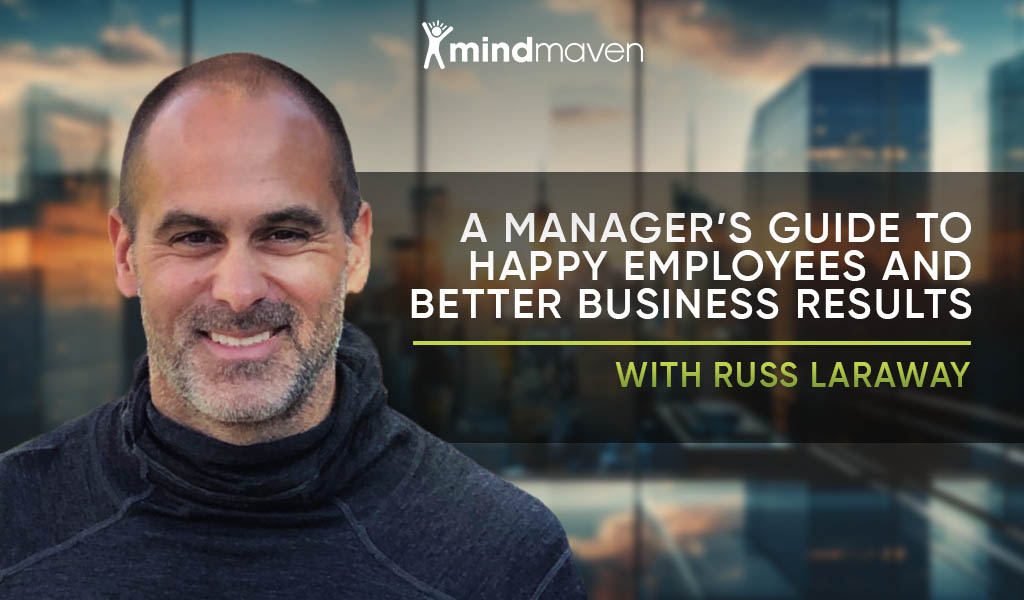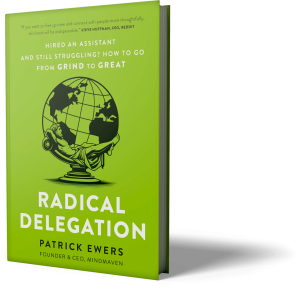Ever wondered what it takes to become a successful manager? It’s not your authority or control; it’s about creating an environment where engaged, happy employees drive better business results.
A notion Russ Laraway refers to as When They Win, You Win.
In this insightful discussion, Russ Laraway, CEO and author of When They Win, You Win, and Patrick Ewers, Founder and CEO of Mindmaven and author of Radical Delegation, discuss why so many managers fail their teams.
Plus, the practical strategies you can implement that result in happy employees and consistent and measurable improvements in team performance.
Table of Contents
ToggleAt the end of the blog, you’ll also gain free instant access to our 10-day Positive Alacrity Challenge.
This challenge helps you put the insights learned into action by leveraging the power of praise to create motivated, high-performing, and happy employees!
When They Win, You Win: A Human Leadership Approach
Russ has built his career on the principles of Human First Leadership, first as a US Marine Corps commander and then, more recently, at Google, Twitter, Qualtrics, and Goodwater.
Continuing his principled approach to management, Russ explains why his book, When They Win, You Win, is inherently human-first.
Russ says: “We spend a lot of time at work. It means a ton to us. You think about Maslow’s hierarchy of needs and how much of that is served by our jobs and our careers.
Whether or not you get the things you want, your manager has a really big role in that.
I think people deserve to be led well. What’s provable, though, is that people aren’t really being led.
Despite the mountains of content aimed at helping managers be better, the truth is they’re not leading better.
What my team at Qualtrics and I did was we studied a set of behaviors – leadership behaviors – that, when practiced regularly, measurably, and predictably, leads to more engaged employees and better business outcomes.”

Why Is Success So Important?
Russ emphasizes the universal desire for workplace success and the pivotal role managers play in creating happy employees who have the right environment to attain it.
Russ explains: “The only thing everybody wants at work is to be successful.
We’re not all there to make friends, we’re not all there to date, we’re not all there to have a good time, we’re not all there to hit the happy hours.
But there is one thing that we all have in common: We want to be successful.
The manager, by a mile, is the person who is most likely to create or destroy the circumstances under which people will either do their best work and be totally psyched while doing it or they won’t.
That’s why I think I can serve humanity a little bit more by focusing on fixing managers at scale.”
How To Improve Employee Engagement
Engaged, happy employees are of critical importance to driving significant improvements in overall business outcomes.
Despite this, Russ highlights the massive engagement problem in the US, largely caused by manager effectiveness, which is twice as severe globally.
Russ reports: “Manager effectiveness explains 70 percent of employee engagement. Employee engagement predicts business results.
What are the behaviors that a manager exhibits that lead to these two things: engagement and results?
Well, it turns out those behaviors tend to be extremely human in nature.
All of which are underpinned by something that I call the universal manager job description.”
Russ’ idea of the universal manager job description focuses on two key responsibilities:
- Delivering aligned results.
- Enabling the success of their team members.
Russ: “You do those two things. You’re going to be a really successful manager.”
The Importance of Clear Expectations
Patrick: “If it’s true that most people go to work because they want success … then helping them be more successful is exactly the human first approach that you’re taking.”
Russ: “It’s almost impossible for someone to be successful if we haven’t clarified what exactly is expected of them.
This is the shocking reality: Most managers are not even sure what they expect, let alone can turn around and articulate to someone what they expect, let alone have a way to measure it.
So, by being a freewheeling, chill bro, chill sis manager, you’re setting people up to fail.
You’re setting people up not to succeed. It’s the only thing they really want, and you’re taking that away from them before you even get started.”
Why Happy Employees Require Praise
Patrick introduces a crucial topic from Russ’s book, When They Win, You Win, noting the importance of praise in creating happy employees.

Patrick: “I think your book talks quite a bit about this concept of giving praise. A lot of people struggle with it because they revolt against it.
Saying, ‘I don’t want to praise people just for the point of praising people because somebody said one should praise folks.’”
Russ: “No praise is a bad outcome, but the instinct just praise because someone told me to—that would be ineffective.
Let’s break it down.”
Continue Coaching: The Five-to-One Ratio
In the quest to create engaged, happy employees, Russ introduces how he balances praise and constructive criticism for a more productive and positive work environment.
Russ: “I call it Continue Coaching. The other word that gets used a lot is the opposite one, which is criticism, which I call Improvement Coaching.
Remember, we’re coaching, whether it’s ‘continue’ or ‘improve,’ to help people be more successful. And so, I talk about a five-to-one.”
As a little league coach in his spare time, Russ adopted the five-to-one praise-to-criticism ratio from the Positive Coaching Alliance, a global nonprofit working with youth athletes.
Russ: “They said five-to-one praise-criticism, or as I would say, five-to-one, continue to improve.
Development was the primary goal, so I started something I called the book. It was literally a lab notebook where all I did was write down what the kids did well.
You showed up on time to practice – I wrote your name down.
You counted loudly during stretching – I wrote your name down.
Then, lull in energy mid-practice, we’d bring the kids in, I’d hold the book up like Lion King. I literally sing the Lion King, and then I’d read from the book.”
Praise Is Not Just for Kids
Now, if you’re thinking, “Sure, that works for kids because they love to be praised,” you wouldn’t be alone. But here’s Russ’s interesting response to why he thinks it’s a mistake to reach that conclusion:
Russ: “Five-to-one that Positive Coaching Alliance offers; where did they get it? Well, they got it from John Gottman, who wrote seven principles for a successful marriage.
I don’t know any kids in 2024 getting married, so I assume that book is aimed at adults. Five-to-one praise criticism is one of seven principles that lead to a successful marriage.
It forced us to be able to articulate our team standards clearly, crisply, repeatedly.
If it’s a different standard for fielding a ground ball every time, the kids are going to be confused. They’ll never get it right.
To communicate those standards, we had to know them, and we didn’t know them at first.
We had to be able to create the standard and then say it, and then say it the same way over and over to the point where the kids could – and that is very useful in the workplace.
The standard for good praise, or good Continue Coaching, isn’t ‘Good job.’ That’s not it. That’s terrible.
It’s specific and sincere relative to your standards.
If you do that, now that’s valuable because now people are hearing directly from you what’s working and what they should repeat. So that’s the idea of five-to-one.”
Workplace Example: How To Give Praise and Criticism at Work
Patrick: “It’s very rare in my life experience that things that work for kids won’t work for adults.
Like for example, structure – anybody who’s a parent will see that the kids are doing better if you give them structure.
I don’t think that goes away just because we grow up.”
Russ explains that in the workplace, the things you can give praise or criticism on – or continue or improve – boil down to two areas:
- Work Product: This includes elements like the analysis someone did, a customer service ticket they handled, the way they ran a meeting or a presentation they gave. These are specific, tangible outputs.
- Behaviors: These are the actions that reflect your core values. Usually, your core values provide the best place to find the behavioral standards in an organization.
To put this into context, Russ provides an example of Continue Coaching using the Situation, Behavior, Impact (SBI) format.
Russ: “So here’s what it might sound like:
‘In our team meeting last week (that’s the situation), when you challenged Steve’s analysis of the customer service issues (that’s the behavior) …
I know it wasn’t easy, but I really appreciate it because when you do that, you help Steve sharpen his analysis, you help us arrive at better conclusions, and you help us fulfill our value of helping everyone on the team around you to be more successful.
Steve’s better off. We’re better off. You’re better off.’
And that’s a case where I praised you for your behavior, and I described exactly where and when – what was the behavior and why it mattered.”
Common Myths of Giving Praise at Work
When it comes to giving praise in the workplace, there are several misconceptions that can undermine its effectiveness and ability to create happy employees.
Patrick highlights a common myth, stating: “I think another pragmatic element is that a lot of folks think praise has to be about something big.”
Russ adds: “I think it’s important to get a durable, consistent set of standards.
What are our durable standards that we can praise for?
Two big mistakes people make with this idea of praise, or as I call it, Continue Coaching:
- It’s got to be big.
- The worst leadership instinct that exists is: ‘I’m going to withhold it because it’ll mean more when I give it.’
Withholding praise because it’ll mean more later is a bad practice as a manager and yet one of the most common poor instincts that managers have.”

Start the 10-Day Positive Alacrity Challenge
Ready to put your new insights into practice for more engaged, happy employees? Then we invite you to embark on our 10-Day Positive Alacrity Challenge.
Positive alacrity is a powerful leadership tactic that consistently delivers micro-experiences that profoundly uplift the people we interact with.
Each skill and scenario-based challenge takes just 30-45 seconds a day, allowing you to build meaningful relationships with no significant time investment necessary.
Despite its simplicity, many have achieved powerful, even life-changing results with this small daily habit.
Here is some of the feedback we’ve received from our startup leader clients:
- Improved reputation as a leader (often resulting in lower attrition rates),
- Lessened CEO loneliness due to a greater sense of connection to the company as a whole and
- Direct influence over one’s company culture through the ability to lead by example.
Positive alacrity is the number one shortcut to creating happy employees and, in turn, creating a long-lasting sense of fulfillment for yourself.
Start today with instant access and see the benefits of a more appreciated and engaged team!


